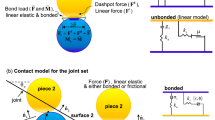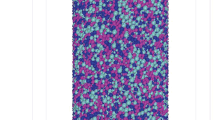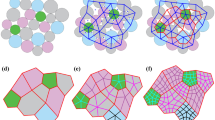Abstract
Rock heterogeneities often control microcracking on the grain scale and therefore the mechanical behavior of the rock on the macroscale. We therefore studied the fracture patterns, mechanical behavior and strength of granular rocks using the three-dimensional numerical modeling code 3DEC. The numerical rock specimens, built using software package Neper, comprised an assemblage of Voronoi polyhedra designed to resemble grains. Different grains, representing different rock-forming minerals, and the contacts between the grains were assigned different mechanical and physical properties, accounting for the grain scale heterogeneity observed in natural granular rocks. The model accurately captured the evolution of damage on the grain scale (tensile and shear microcracks) and the macroscopic mechanical behavior, strength, and failure patterns observed in laboratory experiments performed on sandstone. Based on this validation, we explored the influence of grain size and shape distribution on the mechanical behavior of granular rock. We show that rock specimens characterized by a wide grain size distribution were weaker than those with a narrow grain size distribution, but that grain sphericity distributions does not significantly influence strength. We also found that increasing the initial porosity reduced specimen strength, due to the concentration of stress around the voids, and that intergranular cracking was the dominant contact damage mechanism during uniaxial compression. Due to the ease of flexibility in varying grain scale parameters, we conclude that the model used herein is a powerful tool that can be used to study the mechanical behavior, strength, and failure patterns of rock.
Access this article
We’re sorry, something doesn't seem to be working properly.
Please try refreshing the page. If that doesn't work, please contact support so we can address the problem.





















Similar content being viewed by others
References
Abe S, Mair K (2009) Effects of gouge fragment shape on fault friction: new 3D modelling results. Geophys Res Lett 36(23):L23302. https://doi.org/10.1029/2009GL040684
Al-Harthi AA, Al-Amri RM, Shehata WM (1999) The porosity and engineering properties of vesicular basalt in Saudi Arabia. Eng Geol 54(3–4):313–320
Ashby MF, Sammis CG (1990) The damage mechanics of brittle solids in compression. Pure Appl Geophys 133(3):489–521
Azocar K (2016) Investigating the mesh dependency and upscaling of 3D grain-based models for the simulation of brittle fracture processes in low-porosity crystalline rock. Ph.D thesis, Queen’s University Kingston, Ontario, Canada
Barnett RL, Kerrich R (1980) Stress corrosion cracking of biotite and feldspar. Nature 283(5743):185–187
Bass JD (1995) Elasticity of minerals, glasses, and melts. Min Phys Crystallogr Handb Phys Constants 2:45–63
Baud P, Wong TF, Zhu W (2014) Effects of porosity and crack density on the compressive strength of rocks. Int J Rock Mech Min Sci 67:202–211
Cai M, Kaiser PK, Morioka H, Minami M, Maejima T, Tasaka Y, Kurose H (2007) FLAC/PFC coupled numerical simulation of AE in large-scale underground excavations. Int J Rock Mech Min Sci 44(4):550–564
Chang CD, Zoback MD, Khaksar A (2006) Empirical relations between rock strength and physical properties in sedimentary rocks. J Petrol Sci Eng 51(3–4):223–237
Chen W, Konietzky H, Tan X, Fruhwirt T (2016) Pre-failure damage analysis for brittle rocks under triaxial compression. Comput Geotech 74:45–55
Chen S, Yue ZQ, Tham LG (2007) Digital image based approach for three-dimensional mechanical analysis of heterogeneous rocks. Rock Mech Rock Eng 40(2):145–168
Cundall PA (1988) Formulation of a three-dimensional distinct element model—Part I. A scheme to detect and represent contacts in a system composed of many polyhedral blocks. Int J Rock Mech Min Sci Geomech Abstr 25(3):107–116
Eberhardt E, Stead D, Stimpson B, Read RS (1998) Identifying crack initiation and propagation thresholds in brittle rock. Can Geotech J 35(2):222–233
Eberhardt E, Stimpson B, Stead D (1999) Effects of grain size on the initiation and propagation thresholds of stress-induced brittle fractures. Rock Mech Rock Eng 32(2):81–99
Fabjan T, Ivars DM, Vukadin V (2015) Numerical simulation of intact rock behaviour via the continuum and Voronoi tessellation models: a sensitivity analysis. Acta Geotech Slov 12(2):4–23
Farahmand K, Vazaios I, Diederichs MS, Vlachopoulos N (2018) Investigating the scale-dependency of the geometrical and mechanical properties of a moderately jointed rock using a synthetic rock mass (SRM) approach. Comput Geotech 95:162–179
Feng XQ, Yu SW (2001) Quasi-micromechanical constitutive theory for brittle damaged materials under tension. Acta Mech Solida Sin 14(3):200–207
Fredrich JT, Evans B, Wong TF (1990) Effect of grain size on brittle and semibrittle strength: Implications for micromechanical modelling of failure in compression. J Geophys Res Solid Earth 95(B7):10907–10920
Gao FQ, Stead D, Elmo D (2016) Numerical simulation of microstructure of brittle rock using a grain-breakable distinct element grain-based model. Comput Geotech 78:203–217
Gao F, Kang H (2017) Grain-based discrete-element modeling study on the effects of cementation on the mechanical behavior of low-porosity brittle rocks. Int J Geomech 17(9):04017061. https://doi.org/10.1061/(ASCE)GM.1943-5622.0000957
Gao FQ (2013), Simulation of failure mechanisms around underground coal mine openings using discrete element modelling, PhD Thesis, Science: Department of Earth Sciences, Simon Fraser University
Ghazvinian E, Diederichs M, Quey R (2014) 3D random Voronoi grain-based models for simulation of brittle rock damage and fabric-guided micro-fracturing. J Rock Mech Geotech Eng 6(6):506–521
Griffiths L, Heap MJ, Xu T, Chen CF, Baud P (2017) The influence of pore geometry and orientation on the strength and stiffness of porous rock. J Struct Geol 96:149–160
Hajiabdolmajid V, Kaiser PK, Martin CD (2002) Modelling brittle failure of rock. Int J Rock Mech Min Sci 39(6):731–741
He W, Hayatdavoudi A, Shi H, Sawant K, Huang P (2019) A preliminary fractal interpretation of effects of grain size and grain shape on rock strength. Rock Mech Rock Eng 52(6):1–21
Heap MJ, Wadsworth FB, Xu T, Chen CF, Tang CA (2016) The strength of heterogeneous volcanic rocks: A 2D approximation. J Volcanol Geoth Res 319:1–11
Kazerani T, Zhao J (2010) Micromechanical parameters in bonded particle method for modelling of brittle material failure. Int J Numer Anal Meth Geomech 34(18):1877–1895
Khasin VL (2014) Stochastic model of crack propagation in brittle heterogeneous materials. Int J Eng Sci 82:101–123
Kranz RL (1983) Microcracks in rocks: a review. Tectonophysics 100(1–3):449–480
Lan H, Martin CD, Hu B (2010) Effect of heterogeneity of brittle rock on micromechanical extensile behavior during compression loading. J Geophys Res. https://doi.org/10.1029/2009JB006496
Li J, Konietzky H, Fruhwirt T (2017) Voronoi-Based DEM Simulation Approach for Sandstone Considering Grain Structure and Pore Size. Rock Mech Rock Eng 50(10):2749–2761
Li XF, Li HB, Zhao Y (2017) 3D polycrystalline discrete element method (3PDEM) for simulation of crack initiation and propagation in granular rock. Comput Geotech 90:96–112
Li XF, Zhang QB, Li HB, Zhao J (2018) Grain-Based Discrete Element Method (GB-DEM) Modelling of Multi-scale Fracturing in Rocks Under Dynamic Loading. Rock Mech Rock Eng 51(12):3785–3817
Li SH, Zhang YN, Feng C (2010) A spring system equivalent to continuum model. Discrete Element Methods, Simulation of Discontinua: Theory and Applications. Queen Mary, University of London, London, 75–85
Liang ZZ, Tang CA, Li HX, Xu T, Zhang YB (2004) Numerical simulation of 3-d failure process in heterogeneous rocks. Int J Rock Mech Min Sci 41:323–328
Lockner DA, Byerlee JD, Kuksenko V, Ponomarev A, Sidorin A (1991) Quasi-static fault growth and shear fracture energy in granite. Nature 350(6313):39
Lockner D (1993) The role of acoustic emission in the study of rock fracture, paper presented at International Journal of Rock Mechanics and Mining Sciences & Geomechanics Abstracts, Elsevier
Martin C (1997) Seventeenth Canadian geotechnical colloquium: the effect of cohesion loss and stress path on brittle rock strength. Can Geotech J 34(5):698–725
Martin CD, Chandler NA (1994) The progressive fracture of Lac du Bonnet granite. International Journal of Rock Mechanics and Mining Sciences & Geomechanics Abstracts 31(6):643–659
Massart T, Selvadurai APS (2012) Stress-induced permeability evolution in a quasi-brittle geomaterial. J Geophys Res 117:07207
Mcbeck J, Mair K, Renard F (2019) How porosity controls macroscopic failure via propagating fractures and percolating force chains in porous granular rocks. J Geophys Res 124(9):9920–9939
Muller C, Fruhwirt T, Haase D, Schlegel R, Konietzky H (2018) Modeling deformation and damage of rock salt using the discrete element method. Int J Rock Mech Min Sci 103:230–241
Munjiza A, Owen DRJ, Bicanic N (1995) A combined finite-discrete element method in transient dynamics of fracturing solids. Eng Comput 12(2):145–174
Nemat-Nasser S, Horii H (1984) Rock failure in compression. Int J Eng Sci 22(8):999–1011
Norouzi S, Baghbanan A, Khani A (2013) Investigation of grain size effects on micro/macro-mechanical properties of intact rock using voronoi element—discrete element method approach au—Norouzi, Siavash. Part Sci Technol 31(5):507–514
Palchik V (1999) Influence of porosity and elastic modulus on uniaxial compressive strength in soft brittle porous sandstones. Rock Mech Rock Eng 32(4):303–309
Peng J, Wong LNY, Teh CI (2017) Influence of grain size heterogeneity on strength and microcracking behavior of crystalline rocks. J Geophys Res Solid Earth 122(2):1054–1073
Potyondy DO, Cundall PA (2004) A bonded-particle model for rock. Int J Rock Mech Min Sci 41(8):1329–1364
Potyondy DO (2010) A grain-based model for rock: approaching the true microstructure. Proceedings of rock mechanics in the Nordic Countries, 9–12
Prikryl R (2001) Some microstructural aspects of strength variation in rocks. Int J Rock Mech Min Sci 38(5):671–682
Quey R, Dawson PR, Barbe F (2011) Large-scale 3D random polycrystals for the finite element method: generation, meshing and remeshing. Comput Methods Appl Mech Eng 200(17–20):1729–1745
Quey R (2018) Neper: numerical descriptors of polycrystals (version 3.2)
Sammis CG, Ashby MF (1986) The failure of brittle porous solids under compressive stress states. Acta Metall 34(3):511–526
Scholz CH (1968a) Experimental study of the fracturing process in brittle rock. J Geophys Res 73(4):1447–1454
Scholz CH (1968) The frequency-magnitude relation of microfracturing in rock and its relation to earthquakes. Bull Seismol Soc Am 58(1):399–415
Shakoor A, Bonelli RE (1991) Relationship between petrographic characteristics, engineering index properties, and mechanical properties of selected sandstones. Bull Assoc Eng Geol 28(1):55–71
Van de Steen B, Vervoort A, Napier JAL, Durrheim RJ (2003) Implementation of a flaw model to the fracturing around a vertical shaft. Rock Mech Rock Eng 36(2):143–161
Tang CA (1997) Numerical simulation of progressive rock failure and associated seismicity. Int J Rock Mech Min Sci 34(2):249
Tang CA, Liu H, Lee P, Tsui Y, Tham LG (2000) Numerical studies of the influence of microstructure on rock failure in uniaxial compression—part I: effect of heterogeneity. Int J Rock Mech Min Sci 37(4):555–569
Trask PD, Hammar HE, Wu ZC (1932) Origin and environment of source sediments of petroleum. Gulf Publishing Company, Houston
Vasseur J, Wadsworth FB, Heap MJ, Main IG, Lavallée Y, Dingwell DB (2017) Does an inter-flaw length control the accuracy of rupture forecasting in geological materials? Earth Planet Sci Lett 475:181–189
Villeneuve MC, Diederichs MS, Kaiser PK (2012) Effects of grain scale heterogeneity on rock strength and the chipping process. Int J Geomech 12(6):632–647
Villeneuve MC (2008) Examination of geological influence on machine excavation of highly stressed tunnels in massive hard rock, PhD Thesis, Department of Geological Sciences and Geological Engineering, Queen’s University
Wadell H (1935) Volume, shape, and roundness of quartz particles. J Geol 43(3):250–280
Wang B, Chen Y, Wong TF (2008) A discrete element model for the development of compaction localization in granular rock. J Geophys Res Solid Earth. https://doi.org/10.1029/2006JB004501
Wong TF, Wong RHC, Chau KT, Tang CA (2006) Microcrack statistics, Weibull distribution and micromechanical modeling of compressive failure in rock. Mech Mater 38(7):664–681
Xu T, Tang CA, Zhao J, Li LC, Heap MJ (2012) Modelling the time-dependent rheological behaviour of heterogeneous brittle rocks. Geophys J Int 189(3):1781–1796
Xu T, Zhou GL, Heap MJ, Yang SQ, Konietzky H, Baud P (2018) The modeling of time-dependent deformation and fracturing of brittle rocks under varying confining and pore pressures. Rock Mech Rock Eng 51(10):3241–3263
Xu T, Zhou GL, Heap MJ, Zhu WC, Chen CF, Baud P (2017) The influence of temperature on time-dependent deformation and failure in granite: a mesoscale modeling approach. Rock Mech Rock Eng 50(9):2345–2364
Yao C, Jiang QH, Shao JF (2015) Numerical simulation of damage and failure in brittle rocks using a modified rigid block spring method. Comput Geotech 64:48–60
Zhang XP, Wong LNY (2014) Choosing a proper loading rate for bonded-particle model of intact rock. Int J Fract 189(2):163–179
Zhao X, Zhao J, Cai J, Hefny A (2008) UDEC modelling on wave propagation across fractured rock masses. Comput Geotech 35(1):97–104
Zhu W, Baud P, Vinciguerra S, Wong TF (2016) Micromechanics of brittle faulting and cataclastic flow in Mount Etna basalt. J Geophys Rese Solid Earth 121(6):4268–4289
Zhu DF, Tu SH, Ma HS, Zhang XW (2017) A 3D Voronoi and subdivision model for calibration of rock properties. Modell Simul Mater Sci Eng 25(8):085005
Acknowledgements
The work was jointly supported by National Natural Science Foundation of China (51974062, 41672301, 51950410595), National Key Research and Development Program of China (2017YFC1503100), Fundamental Research Funds for the Central Universities of China (N180101028), a Royal Society International Exchange grant, United Kingdom (IEC\NSFC\170625) and a Partenariats Hubert Curien (PHC) Cai Yuanpei grant, France (36605ZB). The comments of Matteo Demurtas and one anonymous reviewer helped improve this manuscript.
Author information
Authors and Affiliations
Corresponding author
Ethics declarations
Conflict of interest
The authors declare that they have no conflict of interest.
Additional information
Publisher's Note
Springer Nature remains neutral with regard to jurisdictional claims in published maps and institutional affiliations.
Rights and permissions
About this article
Cite this article
Xu, T., Fu, TF., Heap, M.J. et al. Mesoscopic Damage and Fracturing of Heterogeneous Brittle Rocks Based on Three-dimensional Polycrystalline Discrete Element Method. Rock Mech Rock Eng 53, 5389–5409 (2020). https://doi.org/10.1007/s00603-020-02223-y
Received:
Accepted:
Published:
Issue Date:
DOI: https://doi.org/10.1007/s00603-020-02223-y




